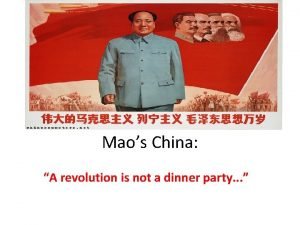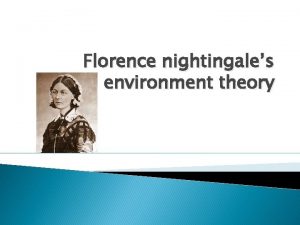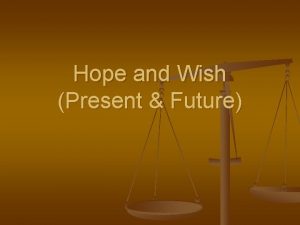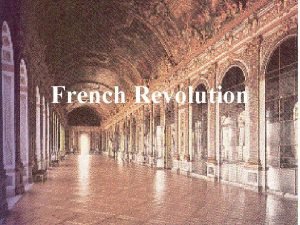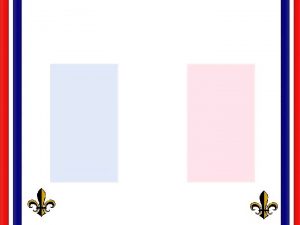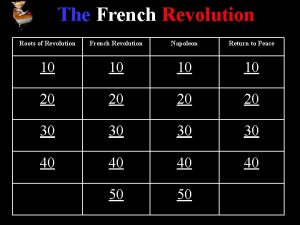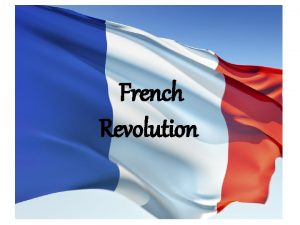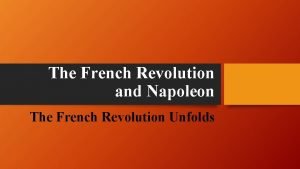FRENCH REVOLUTION The hopes of the party prior









- Slides: 9

FRENCH REVOLUTION The hopes of the party, prior to July 14 th "from such wicked crown & anchor-dreams, good Lord deliver us". [1791]

Links for Political Cartoons: French Revolution *Provided by the Library of Congress • Slide 1: https: //www. loc. gov/item/92518035/ • Slide 3: https: //www. loc. gov/item/2004669853/ • Slide 4: https: //www. loc. gov/item/97521446/ • Slide 6: https: //www. loc. gov/resource/cph. 3 b 51536/ • Slide 9: https: //www. loc. gov/item/2007681338/

Key terms and Figures • Absolutism is a system of government where all political power rests with one ‘absolute’ ruler, usually a tsar, emperor or monarch • Feudalism- the nobility held lands from the Crown in exchange for military service, and vassals were in turn tenants of the nobles, while the peasants were obliged to live on their lord's land give him homage, labor, and a share of the produce, notionally in exchange for military protection. • King Louis XVI – (1754 – 1793) King of France from 1774 to 1792; known as the Sun King, a series of wars at the end of his long reign drained France’s wealth. • Marie-Antoinette (1755 – 1793) Queen of France, wife of King Louis XVI; she was queen during the French Revolution and was disliked by many French citizens. She was found guilty of treason and guillotined. • Bourgeoisie – the urban middle class; merchants & professionals • 1 st Estate- Clergy • 2 nd Estate-Nobles • 3 rd Estate-Bourgeoisie, wealthy middle class that usually profited from business or trade. (at the time of the Revolution, represented the majority of the population) Started French Revolution.

Key Terms and Figures • The Enlightenment was a period of scientific, intellectual and philosophical curiosity that began in the mid-1600 s. It contributed to new thinking and revolutionary ideas, particularly the development of liberal, democratic and republican political theories. • The Bastille was a fortress in eastern Paris, constructed in the 14 th century to defend the city. By the time of the revolution it was being used as an armory, a storage facility and a royal prison for selected detainees. • The Terror refers to the period in the French Revolution from September 5, 1793, to July 27, 1794. Revolutionary government used ‘terror’ against those suspected of being against the revolution. 1400 executed, often without a fair trial.

The French Declaration of the Rights of Man and the Citizen • A document intended to lay out the basic aims of the French Revolution • Based on the principles of liberty and equality • Influenced by enlightenment ideas *Copy of the Declaration of the Rights of Man provided by the Digital Public Library of America

Causes of Discontent • No chance of moving from one Estate to the other (no upward mobility of classes) • France was a Monarchy ruled by the King who had absolute power • France was bankrupt and heavily populated. The King owed money to other countries and decided to raise taxes on everyone except for the nobles who held all political positions. (this angered many people) • Massive famine (people survived off of bread) • Inspired by the American Revolution and the ideas of enlightenment thinkers (people fought against absolute rule) • King Louis XVI not well respected and losing power. The 3 rd Estate formed the National Assembly and eventually overthrew King Louis XVI

Major events • Storming of the Bastille – Start of the French Revolution, July 14, 1789. 1, 000 men, members of the Third Estate, stormed the Bastille – The Bastille itself was said to have housed political prisoners and represented the oppression experienced under the King. – Members of the Third Estate demanded more political participation in government and feared King Louis XVI was about to send the French Army out against the revolutionaries. – Soldiers guarding the Bastille became afraid and fired into the crowd, causing the fighting to begin – Military leader of the Bastille, Governor de Launay could not hold off the rebels and surrendered the Bastille. Launay was beheaded and the Revolution began. – Bastille Day in France is now celebrated similarly to our Independence Day

National Assembly • Created in response to King Louis XVI’s refusal to grant the Third Estate more political power. • Held meetings and began to run the country without the King’s input or approval • Many factions existed within the National Assembly and their named changed many times over the decades following the French Revolution. • The Jacobin Club was the most powerful faction • During the Reign of Terror members within the National Assembly had other members executed.

Reign of Terror • Dark and violent time during the French Revolution. Radical revolutionaries took over government • Executed anyone suspected of being anti-revolutionary. • Led by Maximillien Robespierre • Government ran by a group of men called the Committee of Public Safety • Committee of Public Safety created new laws and made ‘terror’ and official government policy. • Intended to preserve the revolution by any means necessary. • A court was created called the Revolutionary Tribunal often unjustly arresting and convicting people. – Eventually there would be only two verdicts; innocence and death.
 Russian revolution vs french revolution
Russian revolution vs french revolution You should hope that this game will be over soon
You should hope that this game will be over soon Third party vs fourth party
Third party vs fourth party Mao revolution is not a dinner party
Mao revolution is not a dinner party Ventilation and warming florence nightingale
Ventilation and warming florence nightingale Our hopes and expectations
Our hopes and expectations Hopes dreams and aspirations
Hopes dreams and aspirations I wish present
I wish present Third agricultural revolution
Third agricultural revolution Rosetta stone french revolution
Rosetta stone french revolution



